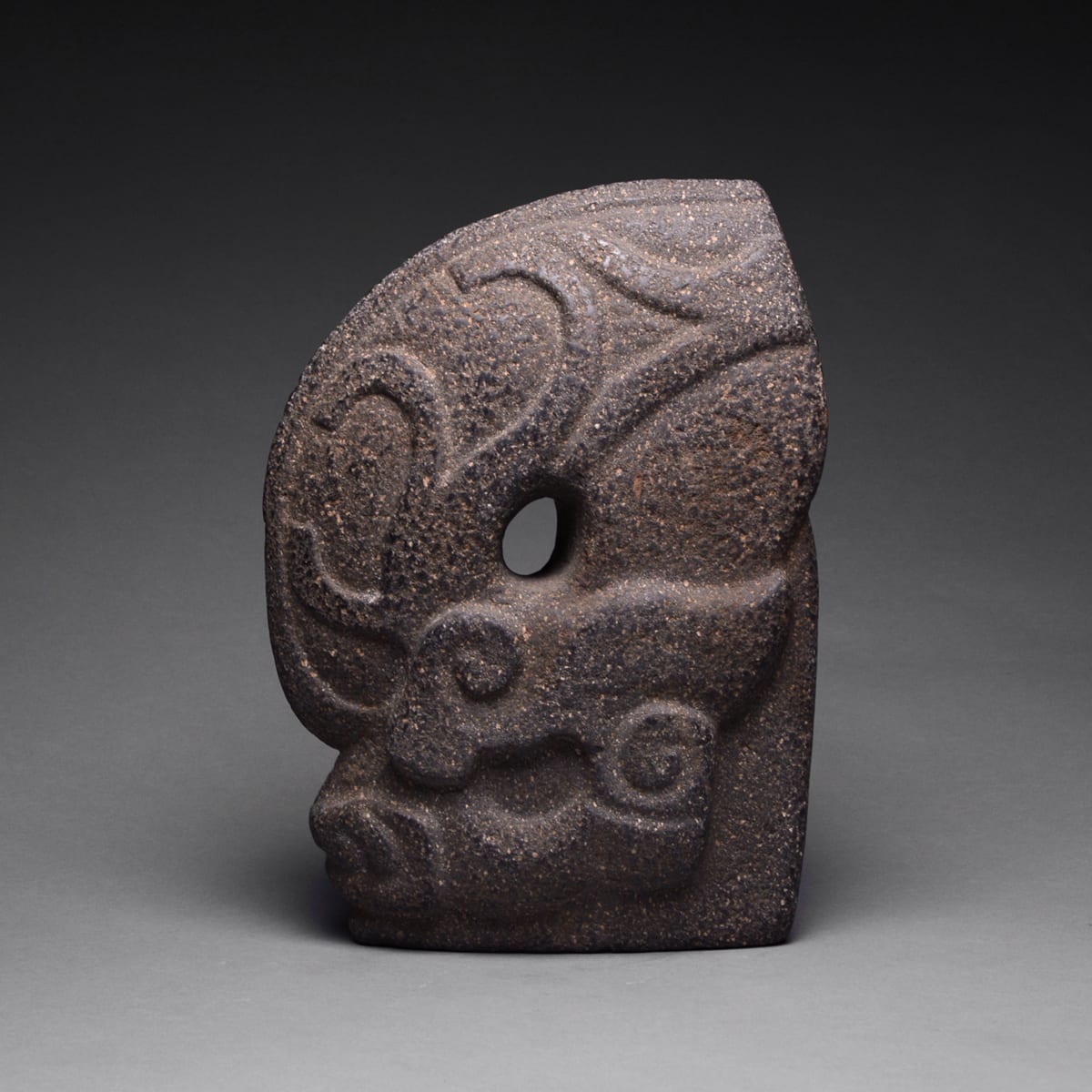Veracruz Stone Hacha, 200 CE - 600 CE
Stone
30.5 x 21 cm
12 x 8 1/4 in
12 x 8 1/4 in
CK.0814
Further images
The Classic Veracruz cultures were small, tightly- packed city states, all governed by hereditary rulers, who sat at the top of highly stratified social structures. Economically, it was based upon...
The Classic Veracruz cultures were small, tightly- packed city states, all governed by hereditary rulers, who sat at the top of highly stratified social structures. Economically, it was based upon slash and burn agricultural techniques, supplemented by exploitation of marine resources, as well as hunting. The culture was fuelled by long- distance trade networks that ran throughout Mesoamerica, as evidenced by the spread of luxury items and exotic goods. In this they strongly resemble the Olmecs, who preceded them and to whom they owed a considerable cultural and artistic debt. Religion was based upon the Olmec “earth monster”, as well as a death god who has been likened to Mictlantecuhtli, a deity worshipped by their cultural neighbour, the Aztecs. Like the Aztecs, they were obsessed with death, sacrifice and the Mesoamerican ballgame, another cultural bequest from the Olmecs. There are accounts stating that the losing team was sacrificed as an offering to the gods; other chroniclers suggest that it might have been used as a substitute for warfare. As a result their iconography is somewhat sanguineous – with decapitations, blood-letting and bound prisoners common themes – surrounded by extensive and convoluted banded scrolls that can be seen both on monumental architecture and on mobile art. A defining characteristic of the Classic Veracruz culture is the presence of stone ballgame gear: yokes, hachas, and palmas. Yokes are U-shaped stones worn about the waist of a ballplayer, while the hachas and palmas sit upon the yoke. These were probably worn ceremonially by the victors; the actual pieces were probably made of wood and leather. Interestingly, while hachas and yokes are found throughout the range, the palmas seem peculiar to what is today northern Veracruz.
The ball game, perhaps ritually signifying the transit of the sun and moon between the celestial and terrestrial spheres, was an important event in Mesoamerican culture, considered necessary to maintain the cosmic cycle. The game was played on a large, I- shaped court enclosed by high walls that had an astrological significance in relation to its alignment. At the midpoint, two stone rings were placed high in the air, about twenty-seven feet high. Apparently, scholars believe that the object of the game was to get the hard rubber ball through one of the hoops without using your feet or hands, only your hips. This is where the yoke comes in. Yokes made from cloth were worn around the players’ hips as protective padding. However, yokes were also made from heavy stone, suggesting that they were created for ceremonial use instead. Because the ballgame was of utmost social and religious significance to the Maya, it is believed that ceremonial ballgames were played. In the Popol Vuh, the most important source of Mayan mythology, a ball game is described taking place between the Hero Twins and the Lords of the Underworld. Upon the victory, the Hero twins, Hunahpu and Xbalanque, were deified as the sun and the moon. Perhaps ritual reenactments of this mythological match were performed in which “players” acting as the hero twins wore such elaborate and impractical equipment. Or perhaps this ball game equipment was merely carved in such durable materials in order to last eternally throughout the afterlife after being buried alongside the deceased.
The ball game, perhaps ritually signifying the transit of the sun and moon between the celestial and terrestrial spheres, was an important event in Mesoamerican culture, considered necessary to maintain the cosmic cycle. The game was played on a large, I- shaped court enclosed by high walls that had an astrological significance in relation to its alignment. At the midpoint, two stone rings were placed high in the air, about twenty-seven feet high. Apparently, scholars believe that the object of the game was to get the hard rubber ball through one of the hoops without using your feet or hands, only your hips. This is where the yoke comes in. Yokes made from cloth were worn around the players’ hips as protective padding. However, yokes were also made from heavy stone, suggesting that they were created for ceremonial use instead. Because the ballgame was of utmost social and religious significance to the Maya, it is believed that ceremonial ballgames were played. In the Popol Vuh, the most important source of Mayan mythology, a ball game is described taking place between the Hero Twins and the Lords of the Underworld. Upon the victory, the Hero twins, Hunahpu and Xbalanque, were deified as the sun and the moon. Perhaps ritual reenactments of this mythological match were performed in which “players” acting as the hero twins wore such elaborate and impractical equipment. Or perhaps this ball game equipment was merely carved in such durable materials in order to last eternally throughout the afterlife after being buried alongside the deceased.







